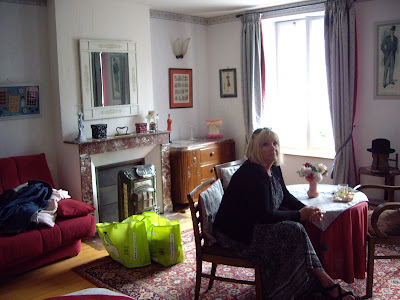
These fields are being cultivated all over Northern France and Germany. Very bright yellow that looks like the wild mustard that grows in California in the spring. But it's rapeseed, used to make canola oil and more recently, bio diesel.
This is our B&B near Verdun. One of the nicest places we've stayed so far. Very large room with lots of antiques. This is a beautiful home owned and operated by Mr. and Mrs Wurtz, a retired couple who grew up in the village. Very nice people and we opted to have dinner with them one night. Five courses with wine, topped off with a home made plum liquor that Mr. Wurtz said was 50% alcohol. After one sip, I didn't doubt him for a minute.
Here's their web site: http://www.lametairiedeverges.com/
We came to Verdun for the WWI sites. On our last trip to France we went to Normandy and went to lots of sites we had learn about over time. We here less about WWI, but had heard of Verdun on many occasions. Cathie's grandfather fought somewhere in the area, although his exact history is unknown. When one thinks of America's overseas military cemeteries, you usually think of Omaha Beach. Near Verdun is the Meuse-Argonne American Cemetery. It encompasses 130 acres captured by the 32nd Infantry Division. Free use of the land, as a permanent burial ground, was granted by the French government in perpetuity, without charge or taxation, as an expression of its gratitude to the United States.
There are 14,246 American war dead interred in the cemetery, most of whom fell during the operations of the First U.S. Army, between September 26 and November 11, 1918. The graves include 486 "unknowns". This is the largest U.S. military cemetery in a foreign county. In the memorial at the site are inscribed the names of the 954 missing, who remains were never recovered.
It is interesting to note that the grounds are overseen by American employees of the American Battle Monuments Commission, some of who live on the site. The cemetery is immaculate. Much better cared for than any monument in Washington DC. Perhaps that's because the man in charge is a U.S. Army General. While we were there, we noticed that some of the crossed were being dug up. We learned that some had become misaligned and they were being realigned so that the rows were straight for all angles.


 One of the many trenches that are still evident today. This area was devoid of trees during the battle of Verdun. The trees have since grown, but you can still see the results of 300 days of bombing, shelling and trench warfare.
One of the many trenches that are still evident today. This area was devoid of trees during the battle of Verdun. The trees have since grown, but you can still see the results of 300 days of bombing, shelling and trench warfare.  This is the interior of the Ossuary at Douaumont, the final resting place of the remains of around 130,000 French and German solders collected from the chaotic battlefield. the remains were initially placed in coffins bearing the names of the sectors where they had been found, in a provisional Ossuary. The current building we erected in 1920 and the remains were entombed beneath the building. These are all unidentified remains. There are windows where one can looked into the burial chambers and see the bones of the fallen. In front of the monument are the grave of 15,000 French solders who were killed in battle. You can read more about the monument here:
This is the interior of the Ossuary at Douaumont, the final resting place of the remains of around 130,000 French and German solders collected from the chaotic battlefield. the remains were initially placed in coffins bearing the names of the sectors where they had been found, in a provisional Ossuary. The current building we erected in 1920 and the remains were entombed beneath the building. These are all unidentified remains. There are windows where one can looked into the burial chambers and see the bones of the fallen. In front of the monument are the grave of 15,000 French solders who were killed in battle. You can read more about the monument here:On the same battlefield are the ruin of several forts built by the French as a defense against invasion. These fort were constructed in the 1880's and were improved upon over time. As the Germans advanced in WWI they captured many of the forts and occupied them until the French took them back later in the war. We toured Fort Douaumont which was a complex of underground tunnels and spaces where the solders lived and worked. The fortifications consisted of machine gun emplacements and large cannon. Quite impressive.
 The above photograph if of a shrine to German solders who were killed and entombed in the walls of the fort as a result of an explosion of munitions.
The above photograph if of a shrine to German solders who were killed and entombed in the walls of the fort as a result of an explosion of munitions.There were over 3 kilometers of tunnel and passages in the fort. Spaces included kitchens, barracks, chapel, and administrative offices, not to mention the armament.



No comments:
Post a Comment